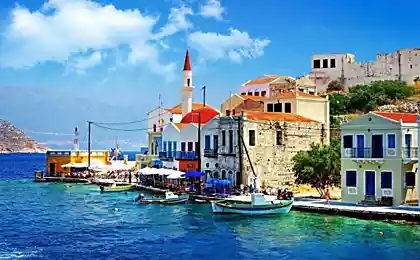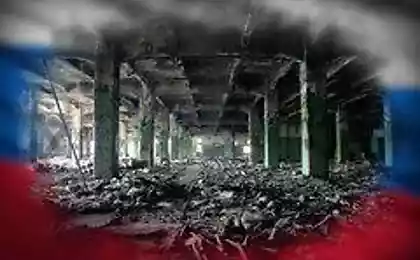1016
10 "post-apocalyptic" places that have become landmarks
Ghost towns and forest on korablePochti in every city in the world has them - the abandoned ruins, broken Titans, defeated and forgotten for a long time, but their silhouettes still rise against the setting sun. The old factories, abandoned stations, even the whole of the island, which was once bubbling with life and who saw a generation of people, and now abandoned and left to die.
But sometimes the increase in entropy gives way to something breathtaking. Some ruins are on the verge of something bigger than anyone could imagine, reborn from the ashes like a phoenix.
1. KolmanskopIstoriya Kolmanskop begins, like many African tragedy with diamonds. In 1908, German settlers were trying to push through the Namib Desert railroad to connect the coast with the Namibian town Keetmanshoop.
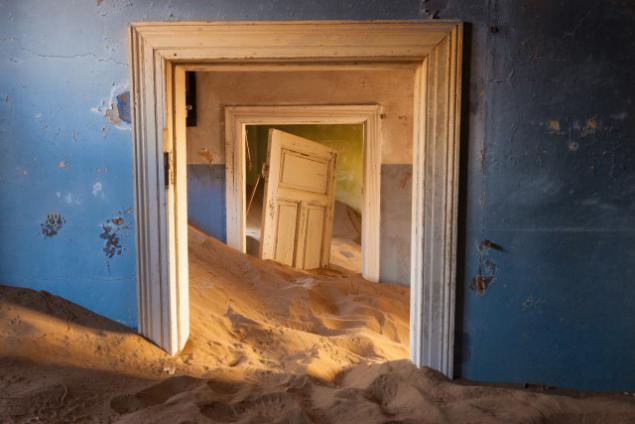
One of the workers, Zachary Levan, found in the sand rough diamond, and brought it to his boss. News of the discovery spread through the German colonies like wildfire, and soon hundreds of seekers filled the desert stones.

Diamonds on the surface is very rare, but legend has it that in Kolmanskop you could go through the desert at night and pick up from the sand in the moonlight sparkling stones. Right on the windswept sand dunes built a city called Kolmanskop, which at the height of the diamond boom, there were more than 1200 residents.

However, times are changing, and because of the fall in diamond prices after the First World War and the discovery of a rich diamond deposits farther south Kolmanskop lost its popularity. The miners and their families left the house and left the desert.

Less than 50 years after Zachary Levan found his diamond Kolmanskop became a ghost town. But the wooden house in the desert do not rot. Within a few years the sand began to penetrate into the open doors and windows of buildings - Namib sought to return everything to its previous state. Today, the entire complex has become a popular tourist destination, attracting visitors to the dunes in half a century mansions, ballrooms, theaters and hospitals.
2. The station signals intelligence ToyfelsbergIskusstvenny dome atop an artificial hill with artificially fears ... This abandoned radar post Cold War era near Berlin in Germany rises from the forest like a beacon, illuminating with its light page confusing stories.

Built in 1963, the station signals intelligence used US National Security Agency during the Cold War to intercept the alleged military and diplomatic messages. The surviving records are too vague and vague to determine the exact nature of the work there. After the fall of the Berlin Wall in 1991, the station was abandoned.

Perhaps more interesting than the station itself, the history of the hill Teufelsberg (Devil's Mountain, in Russian), on which it stands. This hill - the highest point in Berlin, in fact, a huge pile of remnants of the destroyed during the Second World War, the city's buildings, piled on the Nazi military school, which is still intact somewhere under tons of debris.

Since 1991 listens station was turned off, it often changed owners. Each new customer began with ambitious plans to transform dome radome to the hotel, a museum, or something like that, but so far all the plans failed, and there were only strange structure as tombstones at the last Berlin.

Currently closed to the object, but the offenders say that the view from the Devil's Mountain in the city is unbelievable.
3. Boston Long AylendNe be confused with the similarly named island in New York. Boston Long Island wants to be inhabited. This nearly three-kilometer piece of land in the Boston Harbor from the time of colonization in the 17th century was the site of many failed projects.

Its rocky shores and hills overgrown store abandoned military fort, a hospital empty, mysterious tombs and a long list of alleged government secrets.
The stormy history of this area began in 1675, when English settlers sent hundreds of Indians to the islands in the harbor and left them to fend for themselves among the barren rocks of the harsh winter of 1675-1676 years. Most of them died of starvation.
During the Second World War as part of "Operation Paperclip" on Long Island were secretly brought to German scientists. The island is considered to be a source of inspiration when writing Liheyna Dennis novel "Shutter Island».
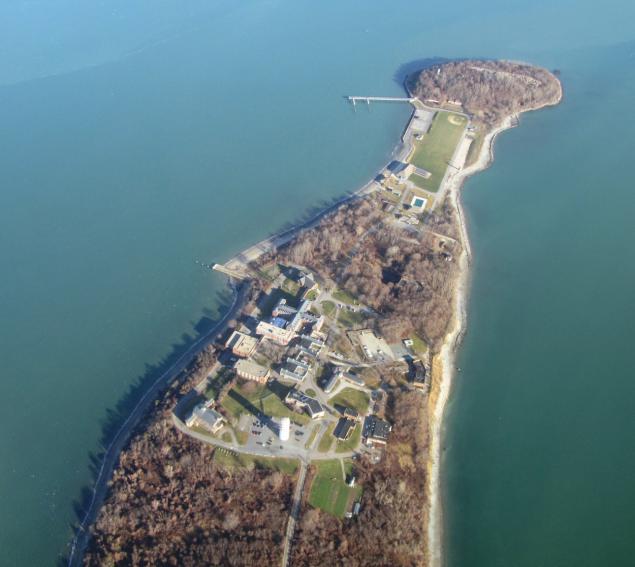
More recently, there is located a homeless shelter in Boston, but for unknown reasons was hurriedly closed in 2014, leaving rows of empty beds in the old tuberculosis hospital.
Citing security concerns, Boston Mayor Martin J.. Walsh closed the bridge leading to Long Island, and all the inhabitants moved to the mainland, has once again turned the island into a ghost town.
4. Abandoned railway line in Paris in 1841 Paris swept the idea of railway transport. Recently, the project was completed a large fortification around the city, and the military were looking for ways to deliver troops and supplies from the city center to the fortress.

Experiencing a difficult financial situation, they enlisted the help of various private companies to pay for the railways, which soon spread from the center to the outskirts of Paris.
The result was a mess. Each line is controlled by a separate company, and nowhere these lines do not intersect. The passengers from the suburbs had to go to the center of Paris only to catch another train that takes them to another point on the edge - sometimes within walking distance from their original point of departure.

Therefore, in Paris, decided to create seinture Petite or Small belt. This line forms a circle just inside the fortified perimeter of the city and connected the other railways. It was a great success, and for nearly 100 years, the line served as one of the main means of transportation in Paris. But in the early 20th century, the need for it invariably began to decline, and by 1934 nearly scored line.
Over the years, Little Belt remained almost untouched. It was overgrown with moss and ivy, and even a few Parisians know of its existence. Nearly 32 kilometers of railway, several tunnels and bridges are hidden in the midst of urban sprawl.
5. Dutch ostrovPochti 400 people once called the Dutch island home. Residents of the island, mostly fishermen and their families, for centuries prepared food directly from the waters of the Chesapeake Bay. But in the end the sea was stopped to give and take.

Eroded shoreline waves and eight-kilometer island is gradually reduced. Like many islands in the Chesapeake Bay, Dutch island consists mainly of silt and clay, and not out of the rocks, and that makes him easy prey for the wind and waves.
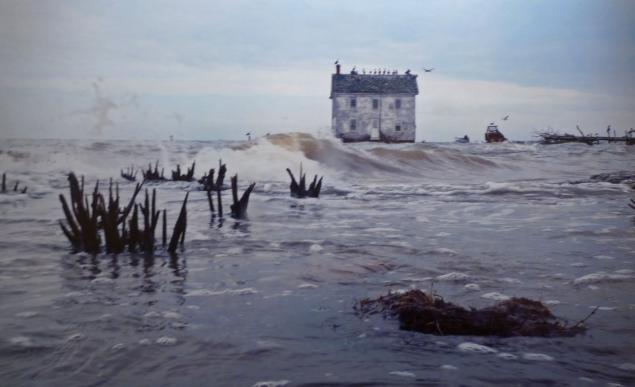
The last inhabitants fled to the island in 1922, leaving their homes and temples as grim monuments to people who lived here once. But they slowly sank into the sea. All but one.

The Last House on the Dutch island survived his brothers, firmly balanced on a thin strip of land that each tide is completely under water. He had an assistant - 15 years dedicated to the preservation of a retired minister of the two-story Victorian mansion surrounded his wood, stone and sandbags in a vain attempt to hold back the sea. Despite all the efforts, and this house, finally gave up the ghost and collapsed in 2010.
6. Tesla Tower in RossiiNadezhnyh sources of information about these strange buildings, located in the middle of the forest, very little. On most sites, where they appear, they dubbed the "Russian Tesla towers." In fact, these towers are the Marx generator, built to convert low voltage DC to high voltage pulse.
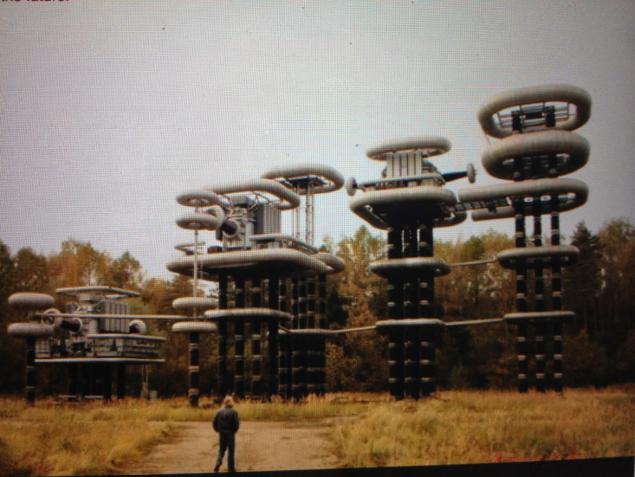
Systems like these Russian giant, albeit on a much smaller scale, now commonly used to simulate lightning on industrial equipment.

The generator was built by the Soviet Union in the 70s for insulation testing of aircraft. When in the early 90s climbed the iron curtain, the world first learned of the test base. Technically complex is not abandoned, as for many years he has periodically given to the temporary use of a private research company.
7. Glass Beach in KaliforniiNepodaleku from Fort Bragg, is a secluded beach, bathed in the bright colors of emeralds, rubies, turquoise and diamonds. But this is not the gems lying around on the sand.

This polished pieces for a hundred years the sea waves glass. From about 1906 residents of Fort Bragg - along with other cities along the coast - dumped their waste directly into the ocean. While the paper is soaked, and plastic allegedly surfaced in distant lands and unknown, glass left.
Only in 1967 it was banned ocean dumping, but the seeds of transformation were sown. Polished waves and sand shards of glass turned into shimmering glass pebbles and were washed ashore.

Although the glass is no longer a rarity, along the beach, sometimes you can find real historical relics: after the Second World War, the automobile companies in the manufacture of tail lights began to use plastic instead of glass, making a strange glass pebbles ruby color from the old headlights something of a rare collector's item.
But now Glass Beach is part of the National Park Makkerriher, so gather there any stones illegally.
8. Ghost Town In Angola, a few miles from the capital of Angola, is a modern high-rise ghost town. Nova Cidade de Kilamba - usually shortened to "Kilamba" - includes 750 residential buildings 2,800 flats. The city was built to house half a million people and has its own schools and commercial premises. He almost all empty.

Miniature city funded by the Chinese construction company and has gone from overgrown bush land to complete the project in less than three years. But instead of the inflow of residents, which they probably expected, the only life that can be found in the complex area of 50 square kilometers - a few Chinese workers (who live outside of the construction site) and many disoriented animal.
According to the Bi-bi-si, the problem lies in the fact that in Angola the class structure consists of "very poor and the very rich," so that buyers of apartments costing $ 200,000 there.
9. Forts MaunsellKak metal animal rising from the dark depths, Maunsell forts stand guard at the mouth of the Thames to the present day. Although they are not as useful as before, but the forts are a silent reminder of our turbulent past.
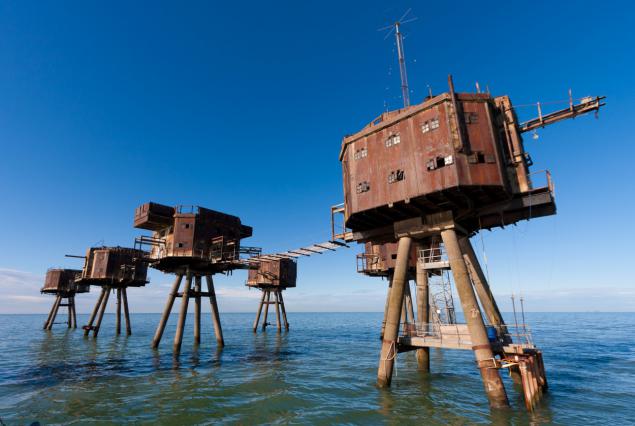
When the threat of German air raids on Britain during the Second World War became a reality, the Department of Defense has put into operation a few sea forts to protect the country's airspace.
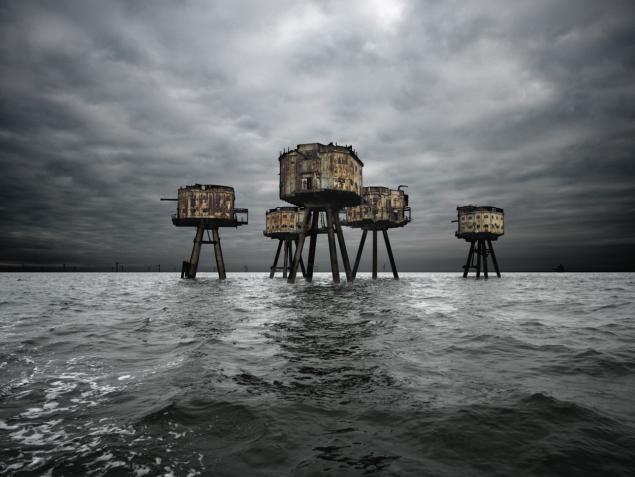
In addition to the four sea forts built six forts for the defense. Three of them have been installed on the River Mersey, and three in the Thames Estuary. Of the three forts in the Thames, only two survived: "Red Sands" and "Quicksand».

The forts were decommissioned after the war and abandoned after they were shot with guns. One of them was captured by a lone Englishman, who has proclaimed his new principality of Sealand.
10. The ship SS AyrfieldEsli sail past the mangroves in Homebush Bay in Sydney, Australia, and look to the northwest, you can see something incredible: a rusted body 100-year-old ship with a growing forest on its decks.

Ship SS Ayrfield was built in 1911 and was used to transport coal from the mainland to work in a coal-fueled ships on the high seas.
During the Second World War Commonwealth Ayrfield requisitioned as a cargo ship to deliver supplies to Allied forces in the Pacific. After the war, the ship returned to his work in the shipping company Miller and in 1972 was decommissioned and sent to die in Homebush Bay.
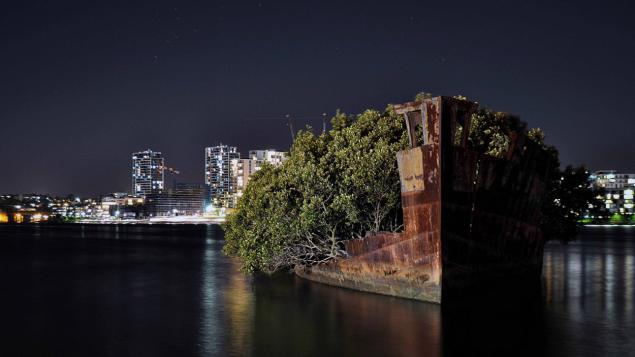
For many years, Homebush Bay was a place where ships are dying. In fact, it was the place where all died - until the heavy metals and dioxin. For decades he served as a reservoir of chemical waste landfill, transforming the once prosperous land into commercial fishing bug.
Since then he has cleared and now only a few rusty ships are visible above the waterline. But SS Ayrfield remains a relic, reminiscent of the past, the bay and the fact that not everything that dies must be dead.
via listverse.com/2015/04/23/10-post-apocalyptic-places-transformed-into-stunning-landmarks/
But sometimes the increase in entropy gives way to something breathtaking. Some ruins are on the verge of something bigger than anyone could imagine, reborn from the ashes like a phoenix.
1. KolmanskopIstoriya Kolmanskop begins, like many African tragedy with diamonds. In 1908, German settlers were trying to push through the Namib Desert railroad to connect the coast with the Namibian town Keetmanshoop.

One of the workers, Zachary Levan, found in the sand rough diamond, and brought it to his boss. News of the discovery spread through the German colonies like wildfire, and soon hundreds of seekers filled the desert stones.

Diamonds on the surface is very rare, but legend has it that in Kolmanskop you could go through the desert at night and pick up from the sand in the moonlight sparkling stones. Right on the windswept sand dunes built a city called Kolmanskop, which at the height of the diamond boom, there were more than 1200 residents.

However, times are changing, and because of the fall in diamond prices after the First World War and the discovery of a rich diamond deposits farther south Kolmanskop lost its popularity. The miners and their families left the house and left the desert.

Less than 50 years after Zachary Levan found his diamond Kolmanskop became a ghost town. But the wooden house in the desert do not rot. Within a few years the sand began to penetrate into the open doors and windows of buildings - Namib sought to return everything to its previous state. Today, the entire complex has become a popular tourist destination, attracting visitors to the dunes in half a century mansions, ballrooms, theaters and hospitals.
2. The station signals intelligence ToyfelsbergIskusstvenny dome atop an artificial hill with artificially fears ... This abandoned radar post Cold War era near Berlin in Germany rises from the forest like a beacon, illuminating with its light page confusing stories.

Built in 1963, the station signals intelligence used US National Security Agency during the Cold War to intercept the alleged military and diplomatic messages. The surviving records are too vague and vague to determine the exact nature of the work there. After the fall of the Berlin Wall in 1991, the station was abandoned.

Perhaps more interesting than the station itself, the history of the hill Teufelsberg (Devil's Mountain, in Russian), on which it stands. This hill - the highest point in Berlin, in fact, a huge pile of remnants of the destroyed during the Second World War, the city's buildings, piled on the Nazi military school, which is still intact somewhere under tons of debris.

Since 1991 listens station was turned off, it often changed owners. Each new customer began with ambitious plans to transform dome radome to the hotel, a museum, or something like that, but so far all the plans failed, and there were only strange structure as tombstones at the last Berlin.

Currently closed to the object, but the offenders say that the view from the Devil's Mountain in the city is unbelievable.
3. Boston Long AylendNe be confused with the similarly named island in New York. Boston Long Island wants to be inhabited. This nearly three-kilometer piece of land in the Boston Harbor from the time of colonization in the 17th century was the site of many failed projects.

Its rocky shores and hills overgrown store abandoned military fort, a hospital empty, mysterious tombs and a long list of alleged government secrets.
The stormy history of this area began in 1675, when English settlers sent hundreds of Indians to the islands in the harbor and left them to fend for themselves among the barren rocks of the harsh winter of 1675-1676 years. Most of them died of starvation.
During the Second World War as part of "Operation Paperclip" on Long Island were secretly brought to German scientists. The island is considered to be a source of inspiration when writing Liheyna Dennis novel "Shutter Island».

More recently, there is located a homeless shelter in Boston, but for unknown reasons was hurriedly closed in 2014, leaving rows of empty beds in the old tuberculosis hospital.
Citing security concerns, Boston Mayor Martin J.. Walsh closed the bridge leading to Long Island, and all the inhabitants moved to the mainland, has once again turned the island into a ghost town.
4. Abandoned railway line in Paris in 1841 Paris swept the idea of railway transport. Recently, the project was completed a large fortification around the city, and the military were looking for ways to deliver troops and supplies from the city center to the fortress.

Experiencing a difficult financial situation, they enlisted the help of various private companies to pay for the railways, which soon spread from the center to the outskirts of Paris.
The result was a mess. Each line is controlled by a separate company, and nowhere these lines do not intersect. The passengers from the suburbs had to go to the center of Paris only to catch another train that takes them to another point on the edge - sometimes within walking distance from their original point of departure.

Therefore, in Paris, decided to create seinture Petite or Small belt. This line forms a circle just inside the fortified perimeter of the city and connected the other railways. It was a great success, and for nearly 100 years, the line served as one of the main means of transportation in Paris. But in the early 20th century, the need for it invariably began to decline, and by 1934 nearly scored line.
Over the years, Little Belt remained almost untouched. It was overgrown with moss and ivy, and even a few Parisians know of its existence. Nearly 32 kilometers of railway, several tunnels and bridges are hidden in the midst of urban sprawl.
5. Dutch ostrovPochti 400 people once called the Dutch island home. Residents of the island, mostly fishermen and their families, for centuries prepared food directly from the waters of the Chesapeake Bay. But in the end the sea was stopped to give and take.

Eroded shoreline waves and eight-kilometer island is gradually reduced. Like many islands in the Chesapeake Bay, Dutch island consists mainly of silt and clay, and not out of the rocks, and that makes him easy prey for the wind and waves.

The last inhabitants fled to the island in 1922, leaving their homes and temples as grim monuments to people who lived here once. But they slowly sank into the sea. All but one.

The Last House on the Dutch island survived his brothers, firmly balanced on a thin strip of land that each tide is completely under water. He had an assistant - 15 years dedicated to the preservation of a retired minister of the two-story Victorian mansion surrounded his wood, stone and sandbags in a vain attempt to hold back the sea. Despite all the efforts, and this house, finally gave up the ghost and collapsed in 2010.
6. Tesla Tower in RossiiNadezhnyh sources of information about these strange buildings, located in the middle of the forest, very little. On most sites, where they appear, they dubbed the "Russian Tesla towers." In fact, these towers are the Marx generator, built to convert low voltage DC to high voltage pulse.

Systems like these Russian giant, albeit on a much smaller scale, now commonly used to simulate lightning on industrial equipment.

The generator was built by the Soviet Union in the 70s for insulation testing of aircraft. When in the early 90s climbed the iron curtain, the world first learned of the test base. Technically complex is not abandoned, as for many years he has periodically given to the temporary use of a private research company.
7. Glass Beach in KaliforniiNepodaleku from Fort Bragg, is a secluded beach, bathed in the bright colors of emeralds, rubies, turquoise and diamonds. But this is not the gems lying around on the sand.

This polished pieces for a hundred years the sea waves glass. From about 1906 residents of Fort Bragg - along with other cities along the coast - dumped their waste directly into the ocean. While the paper is soaked, and plastic allegedly surfaced in distant lands and unknown, glass left.
Only in 1967 it was banned ocean dumping, but the seeds of transformation were sown. Polished waves and sand shards of glass turned into shimmering glass pebbles and were washed ashore.

Although the glass is no longer a rarity, along the beach, sometimes you can find real historical relics: after the Second World War, the automobile companies in the manufacture of tail lights began to use plastic instead of glass, making a strange glass pebbles ruby color from the old headlights something of a rare collector's item.
But now Glass Beach is part of the National Park Makkerriher, so gather there any stones illegally.
8. Ghost Town In Angola, a few miles from the capital of Angola, is a modern high-rise ghost town. Nova Cidade de Kilamba - usually shortened to "Kilamba" - includes 750 residential buildings 2,800 flats. The city was built to house half a million people and has its own schools and commercial premises. He almost all empty.

Miniature city funded by the Chinese construction company and has gone from overgrown bush land to complete the project in less than three years. But instead of the inflow of residents, which they probably expected, the only life that can be found in the complex area of 50 square kilometers - a few Chinese workers (who live outside of the construction site) and many disoriented animal.
According to the Bi-bi-si, the problem lies in the fact that in Angola the class structure consists of "very poor and the very rich," so that buyers of apartments costing $ 200,000 there.
9. Forts MaunsellKak metal animal rising from the dark depths, Maunsell forts stand guard at the mouth of the Thames to the present day. Although they are not as useful as before, but the forts are a silent reminder of our turbulent past.

When the threat of German air raids on Britain during the Second World War became a reality, the Department of Defense has put into operation a few sea forts to protect the country's airspace.

In addition to the four sea forts built six forts for the defense. Three of them have been installed on the River Mersey, and three in the Thames Estuary. Of the three forts in the Thames, only two survived: "Red Sands" and "Quicksand».

The forts were decommissioned after the war and abandoned after they were shot with guns. One of them was captured by a lone Englishman, who has proclaimed his new principality of Sealand.
10. The ship SS AyrfieldEsli sail past the mangroves in Homebush Bay in Sydney, Australia, and look to the northwest, you can see something incredible: a rusted body 100-year-old ship with a growing forest on its decks.

Ship SS Ayrfield was built in 1911 and was used to transport coal from the mainland to work in a coal-fueled ships on the high seas.
During the Second World War Commonwealth Ayrfield requisitioned as a cargo ship to deliver supplies to Allied forces in the Pacific. After the war, the ship returned to his work in the shipping company Miller and in 1972 was decommissioned and sent to die in Homebush Bay.

For many years, Homebush Bay was a place where ships are dying. In fact, it was the place where all died - until the heavy metals and dioxin. For decades he served as a reservoir of chemical waste landfill, transforming the once prosperous land into commercial fishing bug.
Since then he has cleared and now only a few rusty ships are visible above the waterline. But SS Ayrfield remains a relic, reminiscent of the past, the bay and the fact that not everything that dies must be dead.
via listverse.com/2015/04/23/10-post-apocalyptic-places-transformed-into-stunning-landmarks/





